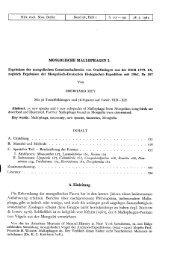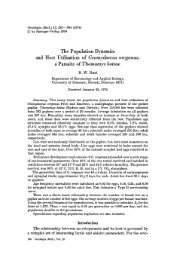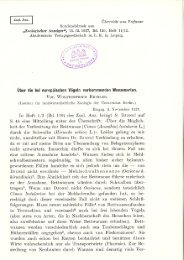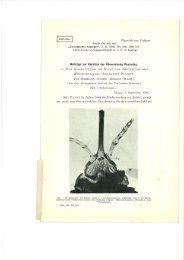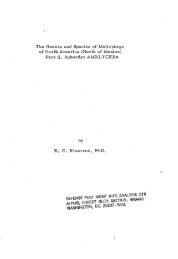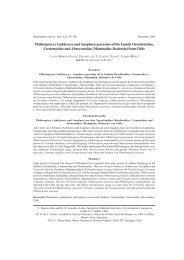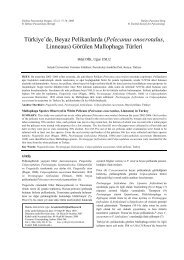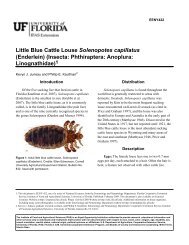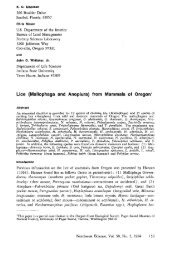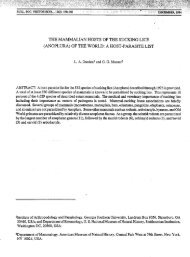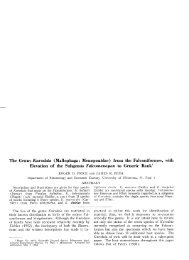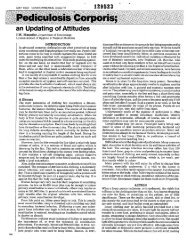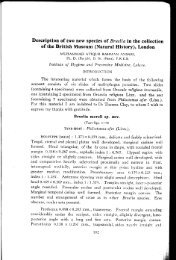The Geographical and Ecological Distribution of Arboreal Psocoptera
The Geographical and Ecological Distribution of Arboreal Psocoptera
The Geographical and Ecological Distribution of Arboreal Psocoptera
Create successful ePaper yourself
Turn your PDF publications into a flip-book with our unique Google optimized e-Paper software.
Annu. Rev. Entomol. 1985.30:175-196. Downloaded from arjournals.annualreviews.org<br />
by Mr. Bas van Berkum on 10/10/07. For personal use only.<br />
Annual Reviews<br />
www.annualreviews.org/aronline<br />
184 THORNTON<br />
tion between differentiation <strong>and</strong> isolation is greater for the stenotopic acraeus<br />
than for the eurytopic dentatus, <strong>and</strong> it appears that both are actively speciating<br />
on the archipelago. In view <strong>of</strong> the known geological history (31),. dispersal<br />
rather than fragmentation events appear to have been the likely precursors <strong>of</strong><br />
differentiation both between archipelago populations <strong>and</strong> between the continental<br />
<strong>and</strong> Galapagos species. A related species, I. texanus, was an early <strong>and</strong><br />
regular colonizer <strong>of</strong> Florida mangrove islets defaunated by tent fumigation<br />
(71).<br />
Temperate South America<br />
<strong>The</strong> temperate South American fauna is rather better known than that <strong>of</strong> the<br />
tropics, particularly west <strong>of</strong> the Andes. Many groups that are typical <strong>of</strong> the<br />
tropics are lacking, <strong>and</strong> the characteristic genus Ptenopsila is endemic to the<br />
region. <strong>The</strong> temperate fauna is less diverse; only a few species are both frequent<br />
<strong>and</strong> abundant, a situation similar to that in northern latitudes. <strong>The</strong> Elipsocidae<br />
appear to have radiated particularly in Chile, where the genera Eolachesilla <strong>and</strong><br />
Roesleria are endemic <strong>and</strong> Nothopsocus is endemic to Chile <strong>and</strong> the Juan<br />
Fern<strong>and</strong>ez Isl<strong>and</strong>s. Although Chile may be regarded as an ecological isl<strong>and</strong><br />
with the Atacama desert to the north <strong>and</strong> mountains to the east, the Andean<br />
barrier declines in significance in the south as the range becomes lower <strong>and</strong><br />
eventually runs into the sea. <strong>The</strong> Valdivian forests possess a rich <strong>and</strong> varied<br />
fauna; the more southern Magellanic forests, dominated by Noth<strong>of</strong>agus, are<br />
impoverished, with an attenuated fauna (63).<br />
<strong>The</strong> arboreal psocid fauna <strong>of</strong> Argentina appears to include southward incursives,<br />
<strong>and</strong> many species there do not occur in Chile. However, in the south, at<br />
least two <strong>of</strong> the four most abundant Chilean species are trans-Andean. <strong>The</strong><br />
Embidopsocinae <strong>and</strong> Pachytroctidae, which are well represented in Brazil <strong>and</strong><br />
Argentina, have not been found in Chile, <strong>and</strong> Sphaeropsocidae appear to be<br />
rare east <strong>of</strong> the Andes yet have nine species in Chile (4). In other genera several<br />
species pairs with a member on each side <strong>of</strong> the Andes have been noted (1).<br />
Of the Juan Fern<strong>and</strong>ez group, only Robinson Crusoe (Mas a Tierra) has been<br />
surveyed (88). <strong>The</strong> nine known species comprise an endemic complex <strong>of</strong> five<br />
Nothopsocus species, a species widely distributed it/Chile, <strong>and</strong> three with an<br />
extensive range <strong>and</strong> probably recently introduced. Remarkably, on the Chilean<br />
mainl<strong>and</strong> Nothopsocus is represented by only two species, which are neither<br />
widely distributed nor common. In contrast, the genus Drymopsocus (also<br />
Elipsocidae), which has four widely distributed species in Chile, was not found<br />
on Robinson Crusoe. Possibly, ecological exclusion is responsible for these<br />
contrasting patterns. <strong>The</strong> families Caeciliidae <strong>and</strong> Philotarsidae, both common<br />
in Chile, also appear to be absent from Robinson Crusoe. <strong>The</strong> Galapagos <strong>and</strong><br />
Robinson Crusoe faunas are strikingly different; elipsocids are not known from<br />
the Galapagos, <strong>and</strong> only Peripsocus nitens, abundant on the Chilean mainl<strong>and</strong>,<br />
is probably common to the two.



